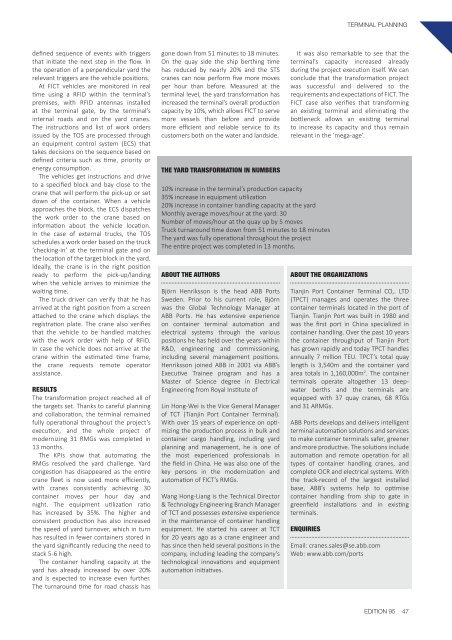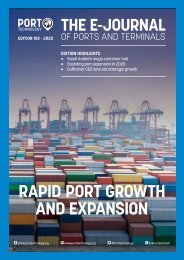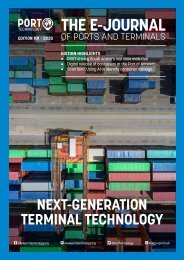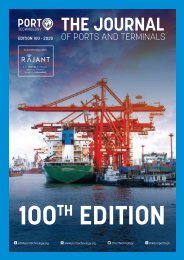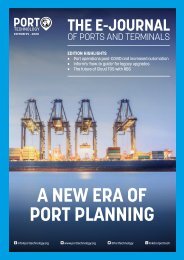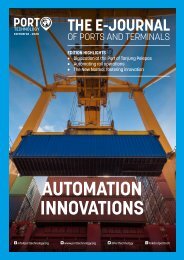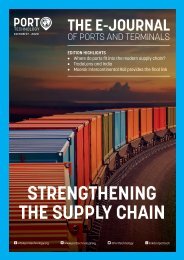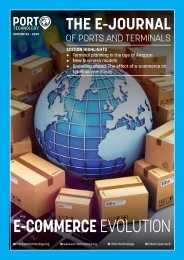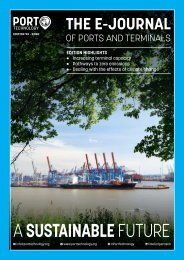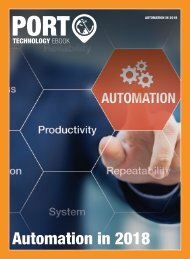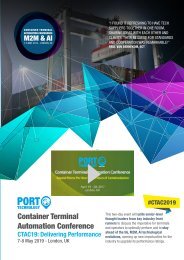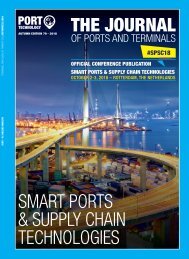Automation's Next Step
This edition of The Journal considers automation of container terminals and how the industry is delivering the next steps towards full and semi-automation. With the inclusion of over 30 technical papers The Journal also explores terminal planning in the age of automation, environmental sustainability for ports, the impact of mega ships and other topics. Automation continues to drive innovation across several industries, and there is no greater example of this than maritime. However, implementation, technology and best practices continue to be a constant source of debate and analysis across the sector, as is shown in this edition of the PTI Journal. The automation debate is not new, but it remains a booming market and a source of growth for the wider container terminal industry. One thing is for certain, automation is here to stay.
This edition of The Journal considers automation of container terminals and how the industry is delivering the next steps towards full and semi-automation.
With the inclusion of over 30 technical papers The Journal also explores terminal planning in the age of automation, environmental sustainability for ports, the impact of mega ships and other topics.
Automation continues to drive innovation across several industries, and there is no greater example of this than maritime.
However, implementation, technology and best practices continue to be a constant source of debate and analysis across the sector, as is shown in this edition of the PTI Journal.
The automation debate is not new, but it remains a booming market and a source of growth for the wider container terminal industry.
One thing is for certain, automation is here to stay.
Create successful ePaper yourself
Turn your PDF publications into a flip-book with our unique Google optimized e-Paper software.
TERMINAL PLANNING<br />
defined sequence of events with triggers<br />
that initiate the next step in the flow. In<br />
the operation of a perpendicular yard the<br />
relevant triggers are the vehicle positions.<br />
At FICT vehicles are monitored in real<br />
time using a RFID within the terminal’s<br />
premises, with RFID antennas installed<br />
at the terminal gate, by the terminal’s<br />
internal roads and on the yard cranes.<br />
The instructions and list of work orders<br />
issued by the TOS are processed through<br />
an equipment control system (ECS) that<br />
takes decisions on the sequence based on<br />
defined criteria such as time, priority or<br />
energy consumption.<br />
The vehicles get instructions and drive<br />
to a specified block and bay close to the<br />
crane that will perform the pick-up or set<br />
down of the container. When a vehicle<br />
approaches the block, the ECS dispatches<br />
the work order to the crane based on<br />
information about the vehicle location.<br />
In the case of external trucks, the TOS<br />
schedules a work order based on the truck<br />
‘checking-in’ at the terminal gate and on<br />
the location of the target block in the yard.<br />
Ideally, the crane is in the right position<br />
ready to perform the pick-up/landing<br />
when the vehicle arrives to minimize the<br />
waiting time.<br />
The truck driver can verify that he has<br />
arrived at the right position from a screen<br />
attached to the crane which displays the<br />
registration plate. The crane also verifies<br />
that the vehicle to be handled matches<br />
with the work order with help of RFID.<br />
In case the vehicle does not arrive at the<br />
crane within the estimated time frame,<br />
the crane requests remote operator<br />
assistance.<br />
RESULTS<br />
The transformation project reached all of<br />
the targets set. Thanks to careful planning<br />
and collaboration, the terminal remained<br />
fully operational throughout the project’s<br />
execution, and the whole project of<br />
modernizing 31 RMGs was completed in<br />
13 months.<br />
The KPIs show that automating the<br />
RMGs resolved the yard challenge. Yard<br />
congestion has disappeared as the entire<br />
crane fleet is now used more efficiently,<br />
with cranes consistently achieving 30<br />
container moves per hour day and<br />
night. The equipment utilization ratio<br />
has increased by 35%. The higher and<br />
consistent production has also increased<br />
the speed of yard turnover, which in turn<br />
has resulted in fewer containers stored in<br />
the yard significantly reducing the need to<br />
stack 5-6 high.<br />
The container handling capacity at the<br />
yard has already increased by over 20%<br />
and is expected to increase even further.<br />
The turnaround time for road chassis has<br />
gone down from 51 minutes to 18 minutes.<br />
On the quay side the ship berthing time<br />
has reduced by nearly 20% and the STS<br />
cranes can now perform five more moves<br />
per hour than before. Measured at the<br />
terminal level, the yard transformation has<br />
increased the terminal’s overall production<br />
capacity by 10%, which allows FICT to serve<br />
more vessels than before and provide<br />
more efficient and reliable service to its<br />
customers both on the water and landside.<br />
THE YARD TRANSFORMATION IN NUMBERS<br />
10% increase in the terminal’s production capacity<br />
35% increase in equipment utilization<br />
20% increase in container handling capacity at the yard<br />
Monthly average moves/hour at the yard: 30<br />
Number of moves/hour at the quay up by 5 moves<br />
Truck turnaround time down from 51 minutes to 18 minutes<br />
The yard was fully operational throughout the project<br />
The entire project was completed in 13 months.<br />
ABOUT THE AUTHORS<br />
Björn Henriksson is the head ABB Ports<br />
Sweden. Prior to his current role, Björn<br />
was the Global Technology Manager at<br />
ABB Ports. He has extensive experience<br />
on container terminal automation and<br />
electrical systems through the various<br />
positions he has held over the years within<br />
R&D, engineering and commissioning,<br />
including several management positions.<br />
Henriksson joined ABB in 2001 via ABB’s<br />
Executive Trainee program and has a<br />
Master of Science degree in Electrical<br />
Engineering from Royal Institute of<br />
Lin Hong-Wei is the Vice General Manager<br />
of TCT (Tianjin Port Container Terminal).<br />
With over 15 years of experience on optimizing<br />
the production process in bulk and<br />
container cargo handling, including yard<br />
planning and management, he is one of<br />
the most experienced professionals in<br />
the field in China. He was also one of the<br />
key persons in the modernization and<br />
automation of FICT’s RMGs.<br />
Wang Hong-Liang is the Technical Director<br />
& Technology Engineering Branch Manager<br />
of TCT and possesses extensive experience<br />
in the maintenance of container handling<br />
equipment. He started his career at TCT<br />
for 20 years ago as a crane engineer and<br />
has since then held several positions in the<br />
company, including leading the company’s<br />
technological innovations and equipment<br />
automation initiatives.<br />
It was also remarkable to see that the<br />
terminal’s capacity increased already<br />
during the project execution itself. We can<br />
conclude that the transformation project<br />
was successful and delivered to the<br />
requirements and expectations of FICT. The<br />
FICT case also verifies that transforming<br />
an existing terminal and eliminating the<br />
bottleneck allows an existing terminal<br />
to increase its capacity and thus remain<br />
relevant in the ‘mega-age’.<br />
ABOUT THE ORGANIZATIONS<br />
Tianjin Port Container Terminal CO,. LTD<br />
(TPCT) manages and operates the three<br />
container terminals located in the port of<br />
Tianjin. Tianjin Port was built in 1980 and<br />
was the first port in China specialized in<br />
container handling. Over the past 10 years<br />
the container throughput of Tianjin Port<br />
has grown rapidly and today TPCT handles<br />
annually 7 million TEU. TPCT’s total quay<br />
length is 3,540m and the container yard<br />
area totals in 1,160,000m 2 . The container<br />
terminals operate altogether 13 deepwater<br />
berths and the terminals are<br />
equipped with 37 quay cranes, 68 RTGs<br />
and 31 ARMGs.<br />
ABB Ports develops and delivers intelligent<br />
terminal automation solutions and services<br />
to make container terminals safer, greener<br />
and more productive. The solutions include<br />
automation and remote operation for all<br />
types of container handling cranes, and<br />
complete OCR and electrical systems. With<br />
the track-record of the largest installed<br />
base, ABB’s systems help to optimise<br />
container handling from ship to gate in<br />
greenfield installations and in existing<br />
terminals.<br />
ENQUIRIES<br />
Email: cranes.sales@se.abb.com<br />
Web: www.abb.com/ports<br />
EDITION 95 47


